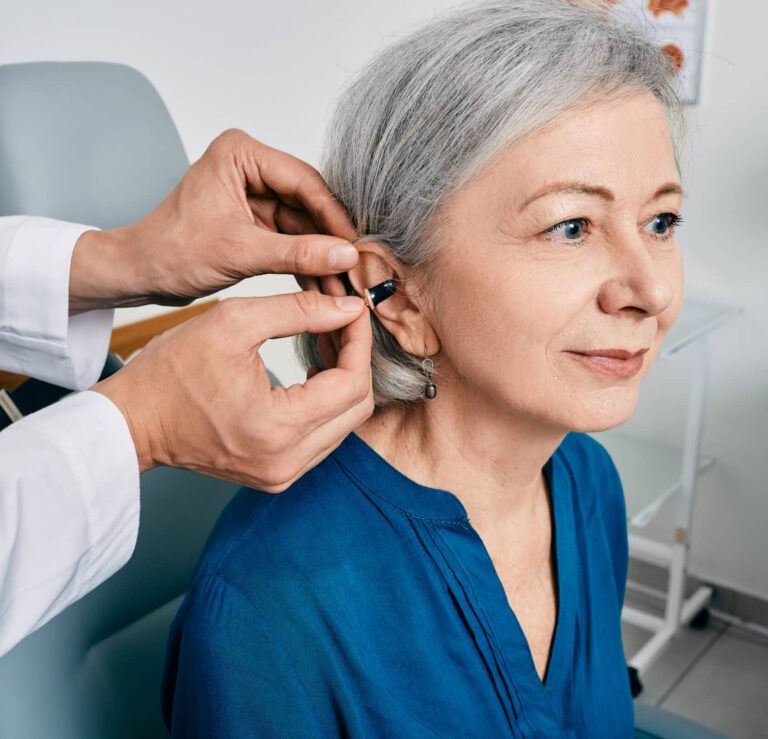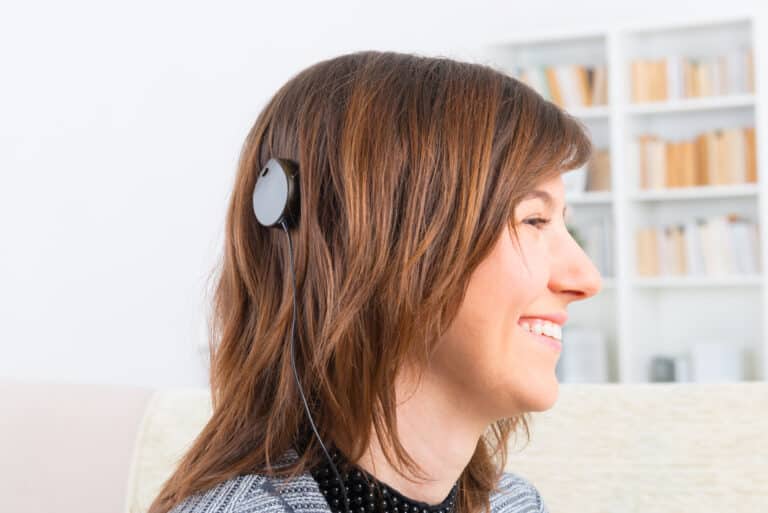Impaired hearing diminishes the ability to hear sounds, discriminate voices and follow conversation. While many factors can cause hearing loss or deafness, the most common reasons are age, genetics and prolonged exposure to loud noises.
The Different Levels of Hearing Impairment
The varying levels of hearing impairment are generally understood as being slight or mild, moderate, severe, and profound.
Overall, hearing impairment is graded according to its level of severity, and can be described both in the reduction of decibels (dB) and its effect on everyday life.
- Slight or mild (26-40 dB): It may be hard to understand soft speech, or to follow a conversation in a noisy environment. Hearing aids might be required.
- Moderate (41-60 dB): It can be difficult to comprehend voice at normal conversational levels, especially in the presence of background noise. The use of a hearing device and the elimination of background noise are recommended. Visual cues, such as lip reading and facial expressions, are very helpful.
- Severe (61-80 dB): Voices cannot be understood without the use of a hearing device. The clarity of speech may be severely impacted. Loud speech, directly into the ear, can be heard. Conversation is very difficult. Lip reading or captions are highly recommended to assist comprehension.
- Profound: (over 80 dB): Hearing devices and their benefits will vary greatly for those with profound hearing loss. Some might find face-to-face speech understandable with the aid of a hearing device in good conditions (e.g., slower speech and no background noise) but most will require captioning (voice to text).
Why Technologies for the Hearing Impaired Matter
According to the Australian Network on Disability, it is estimated that approximately 3.6 million Australians, or 14.5% of the population, have some degree of hearing loss.
Furthermore, it is predicted that the number of Australians with hearing loss will increase to 7.8 million, or 20% of the population, by 2060 due to aging of the population and exposure to noise. Also based on this research, it’s understood that nearly half of those currently suffering from hearing loss are of working age (16-64 years old).
If you find these statistics alarming, you wouldn’t be alone.
Hearing loss has a severe impact on the individual as it affects their ability to communicate and interact with the world around them. This can, of course, lead to diminished communication with family, friends, colleagues and service providers, and impacts mental, social and economic well-being.
As a result, it’s essential that when looking into technologies and solutions for those with a hearing impairment, the ability to foster face-to-face communication is kept at the forefront of the selection criteria.
Hearing Aids: Advanced Tech That Makes Hearing Easier
One of the most widely-promoted yet underused technological solutions to hearing impairment is the hearing aid.

According to the United Kingdom’s Action on Hearing Loss charity, it is estimated that around 6.7 million people in the UK could benefit from using hearing aids, but only around 2 million people actually use them.
While ongoing education around the usefulness of hearing aids is paramount, these statistics also indicate that it’s important to consider a full range of technologies that can assist the hearing impaired people in your life to live comfortably and with dignity.
Cochlear Implants: Great for Hearing Loss
Cochlear implants and hearing aids are both options for individuals with hearing loss, but they work in different ways and are used for different levels of hearing loss.
According to the American National Institute on Deafness and Other Communication Disorders (NIDCD), as of 2021, approximately 324,000 people in the United States have received cochlear implants.
Hearing aids are generally used for individuals with mild to moderate hearing loss. They amplify sounds and make them louder, which can make it easier for people with hearing loss to hear and understand speech and other sounds. However, hearing aids are not able to restore normal hearing, and they may not be effective for individuals with severe or profound hearing loss.
On the other hand, cochlear implant, are electronic devices that are surgically implanted in the inner ear. They bypass the damaged or non-functioning parts of the inner ear and directly stimulate the auditory nerve, which sends sound signals to the brain.
Cochlear implants are typically used for individuals with severe to profound hearing loss who are not able to benefit from hearing aids. They can provide better speech understanding and sound quality than hearing aids for many people with severe hearing loss.

Overall, the decision to use a cochlear implant versus a hearing aid depends on the type and degree of hearing loss, as well as individual factors such as communication needs and preferences. An audiologist or hearing healthcare professional can help determine which option is best for each individual.
Captioning Technology: Making Audio Content Accessible
Captioning technology is often a far more affordable and accessible communication technology available to those who are hearing impaired.

Captioning technology is a type of assistive technology that provides text-based captions or subtitles for audio and video content. It can be used to make media accessible to individuals who are deaf or hard-of-hearing, as well as individuals who may have difficulty understanding spoken language due to cognitive or language-related disabilities.
One great example of captioning technology is the Konnekt Captioning Videophone.
With its fast, accurate and private captioning capabilities available in multiple languages, the Konnekt Videophone is an accessible technology for people of all ages who experience Deafness or hearing impairment.
You can learn more about other people’s overwhelmingly positive experiences with Konnekt products here.
Assistive Listening Tools for Better Hearing
Let’s take a look at two great examples:
- Live Transcribe by Google
- The Roger Pen
Live Transcribe
This service is aimed at those with hearing impairments. It is an app that can be downloaded via the Play Store on Android devices. The phone’s microphone is used to transcribe speech in real time.
Interestingly, the app transcribes more than 70 languages, including Portuguese, French and Swahili and is able to switch between any 2 languages at a given time. There is also a keyboard to assist those who prefer typing out a response.
While this sounds ideal for those who have mild and moderate hearing loss, as it can help bridge the gap in face-to-face conversation, it is not so suitable for those with severe or profound hearing loss. It can be very difficult to use this in a crowded place because the microphone is likely to pick up multiple voices and background noise, as well as the user’s end of the conversation.
Live Transcribe may also be less suitable for use over the phone. This is because the user requires two devices – one upon which to run Live Transcribe and another to use as an actual phone. The text also disappears once the app is closed, so a user might lose the conversation if the app is closed by mistake.
The Roger Pen
The Roger Pen is a discreetly designed, wireless microphone that can be used in combination with hearing aids for those that have hearing loss. It helps you to hear and understand speech better in the presence of noise and over distance.
What’s more, the Roger Pen sends the signal automatically with high-quality sound, and can be connected to mobile phones and other devices via an audio cable or (on some models) wirelessly via Bluetooth.
The Roger Pen has small receivers that can be attached directly to hearing aids and cochlear implants that have a telecoil. It can transmit the sound signal to your hearing aids or Cochlear implant via a miniature Bluetooth receiver or hearing processor unit that is typically available for all Cochlear implants and for many hearing aids.
The Roger Pen is a great device for those looking for something to make their auditory experience richer. It can easily be paired with devices such as the Konnekt Captioning Videophone to capture speech better during a phone call or video call, and make conversations much easier.
It can also be connected to mobile phones via Bluetooth, and has the capability to stream sound from televisions, computers, gaming systems, and more by connecting these devices to the Roger Pen’s charging dock or USB socket.
Some reported limitations of the Roger Pen include connection issues, clarity of sound and remembering to always have it on you.
Wrapping Up
Feeling inspired to take action on behalf of the hearing impaired people in your life?
To find out more about combatting the effects of social isolation using assistive technologies, check out this resource and consider clicking through to learn more about Konnekt’s state-of-the-art communications technology.
References:
- “Cochlear Implants”, National Institute on Deafness and Other Communication Disorders
- “Disability Statistics”, Australian Network on Disability
- “Facts and Figures”, Action Hearing Loss
